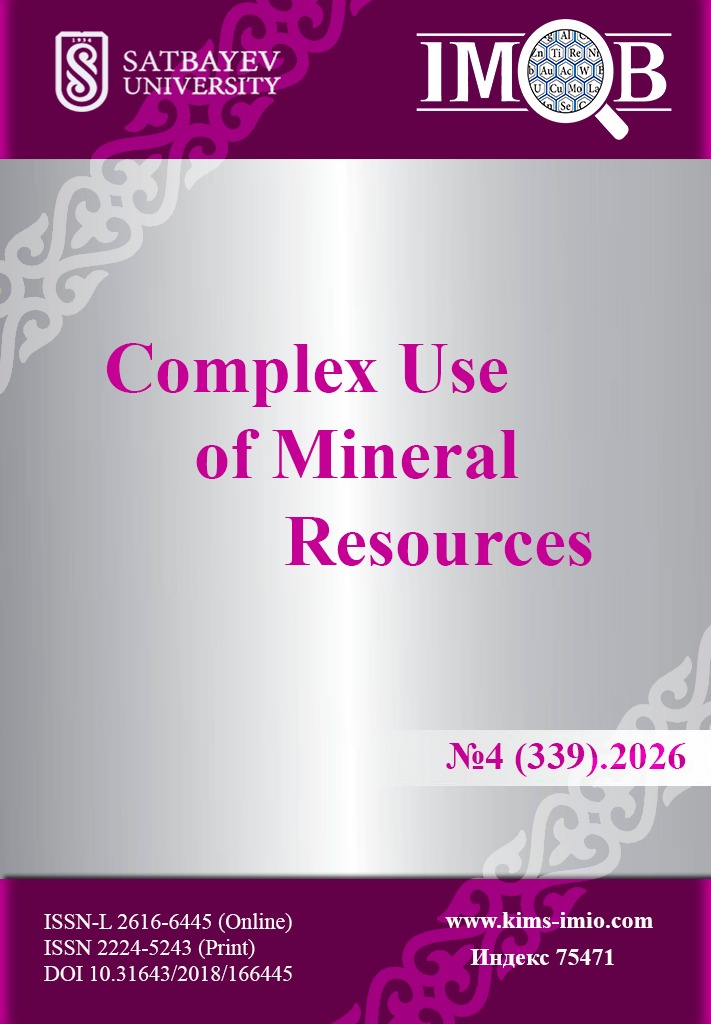Morphological and Crystallographic Investigation of CVD-Grown MoS₂
DOI:
https://doi.org/10.31643/2026/6445.38Keywords:
Molybdenum disulfide, CVD synthesis, 2D materials, Raman spectroscopy, morphology.Abstract
This paper presents a study of the structural characteristics of a promising MoS2-based material obtained by chemical vapor deposition (CVD). Optimization of the synthesis process to obtain the desired structure is also presented. The optimal parameter for the synthesis of CVD MoS2 crystals was found to be the maximum sulfurization temperature of 780 °C with an exposure time of about 15 minutes, the heating temperature of the sulfur source zone of 250 °C, the distance between the sulfur and molybdenum sources of 25 cm, and the distance between the molybdenum source and the substrate was 1.5 cm. The morphology and elemental composition of the obtained samples were studied using scanning electron microscopy (SEM) with energy dispersive X-ray spectroscopy (EDS). Using SEM, it was revealed that MoS2 crystals are formed in a triangular shape and are evenly distributed over the surface of the substrate. The maximum sizes of crystallites reach 6 microns. EMF mapping of crystallites confirmed the homogeneous distribution of molybdenum and sulfur in the structure, revealing only minor variations in composition at the grain boundaries. The quality and quantity of the sample layer were studied using Raman spectroscopy. The results showed two characteristic peaks (vibrational modes E2g1 and A1g) of nanoscale MoS2. The peaks have a sharp shape and are located at a distance of ≈20.9 cm-1, which may indicate the high quality of the crystal structure of the obtained crystallites. The results obtained emphasize the effectiveness of the chosen approach and the importance of the work for the development of 2D materials technologies.
Downloads
References
Ye M, Winslow D, Zhang D, Pandey R, Yap Y. Recent advancement on the optical properties of two-dimensional molybdenum disulfide (MoS2) thin films. Photonics. 2015; 2(1):288-307. https://doi.org/10.3390/photonics2010288
Tobis M. Controlling structure and morphology of MoS2 via sulfur precursor for optimized pseudocapacitive lithium intercalation hosts. ChemRxiv. 2024. https://doi.org/10.26434/chemrxiv-2024-7hz4h
Pak S, Lim J, Hong J, Cha S. Enhanced hydrogen evolution reaction in surface functionalized MoS2 monolayers. Catalysts. 2021; 11(1):70. https://doi.org/10.3390/catal11010070
Zhang G, Liu H, Qu J, & Li J. Two-dimensional layered MoS2: rational design, properties and electrochemical applications. Energy & Environmental Science. 2016; 9(4):1190-1209. https://doi.org/10.1039/c5ee03761a
Khac B, and Chung K. Quantitative assessment of friction characteristics of single-layer MoS2 and graphene using atomic force microscopy. Journal of Nanoscience and Nanotechnology. 2016; 16(5):4428-4433. https://doi.org/10.1166/jnn.2016.11004
Kong N, Wei B, Li D, Zhuang Y, Sun G, Wang B. A study on the tribological property of MoS2/Ti– MoS2/Si multilayer nanocomposite coating deposited by magnetron sputtering. RSC Advances. 2020; 10(16):9633-9642. https://doi.org/10.1039/d0ra01074j
Ermolaev G, Stebunov Y, Vyshnevyy A, Tatarkin D, Yakubovsky D, Novikov S, Volkov V. Broadband optical properties of monolayer and bulk MoS2. NPJ 2D Materials and Applications. 2020; 4(1). https://doi.org/10.1038/s41699-020-0155-x
Eda G, Yamaguchi H, Voiry D, Fujita T, Chen M, Chhowalla M. Photoluminescence from chemically exfoliated MoS2. Nano Letters. 2011; 11(12):5111-5116. https://doi.org/10.1021/nl201874w
Lin H, Wang C, Wu J, Xu Z, Huang Y, Zhang C. Colloidal synthesis of MoS2 quantum dots: size-dependent tunable photoluminescence and bioimaging. New Journal of Chemistry. 2015; 39(11):8492-8497. https://doi.org/10.1039/c5nj01698c
Zhao K. Flexible resistive gas sensor based on molybdenum disulfide-modified polypyrrole for trace NO2 detection. Polymers. 2024; 16(13):1940. https://doi.org/10.3390/polym16131940
Samy O, Zeng S, Birowosuto M, & Moutaouakil A. A review on MoS2 properties, synthesis, sensing applications and challenges. Crystals. 2021; 11(4):355. https://doi.org/10.3390/cryst11040355
Zou J, Cai Z, Lai Y, Tan J, Zhang R, Feng S, Cheng HM. Doping concentration modulation in vanadium-doped monolayer molybdenum disulfide for synaptic transistors. ACS Nano. 2021; 15(4):7340-7347. https://doi.org/10.1021/acsnano.0c09349
Pak S. Controlled p-type doping of MoS2 monolayer by copper chloride. Nanomaterials. 2022; 12(17):2893. https://doi.org/10.3390/nano12172893
Dai X, Du K, Li Z, Liu M, Ma Y, Sun H, Zhang X, Yang Y. Co-doped MoS2 nanosheets with the dominant CoMoS phase coated on carbon as an excellent electrocatalyst for hydrogen evolution. ACS Applied Materials & Interfaces. 2015; 7(49):27242-27253. https://doi.org/10.1021/acsami.5b08420
Kosnan MA, Azam MA, Munawar RF, Klimkowicz A, Takasaki A. Structural, Morphological, and Electrochemical Properties of MXene/MoS2-based Supercapacitor. International Journal of Nanoelectronics and Materials (IJNeaM). 2024; 17:263-273. https://doi.org/10.58915/ijneam.v17iJune.867
Morant‐Giner M, Brotons‐Alcázar I, Shmelev NY, Gushchin AL, Norman LT, Khlobystov AN, & Coronado E. WS₂/MoS₂ heterostructures through thermal treatment of MoS2 layers electrostatically functionalized with W₃S₄ molecular clusters. Chemistry – A European Journal. 2020; 26(29):6670-6678. https://doi.org/10.1002/chem.202000248
Poudel Y, Sławińska J, Gopal P, Seetharaman S, Hennighausen Z, Kar S, & Neogi A. Absorption and emission modulation in a MoS2–GaN (0001) heterostructure by interface phonon–exciton coupling. Photonics Research. 2019; 7(12):1511-1520. https://doi.org/10.1364/PRJ.7.001511
Li Z, Bretscher H, Zhang Y, Delport G, Xiao J, Lee A, Rao A. Mechanistic insight into the chemical treatments of monolayer transition metal disulfides for photoluminescence enhancement. Nature Communications. 2021; 12(1):6044. https://doi.org/10.1038/s41467-021-26378-0
Tanoh AOA, Alexander-Webber J, Xiao J, Delport G, Williams CA, Bretscher H, Rao A. Enhancing photoluminescence and mobilities in WS2 monolayers with oleic acid ligands. Nano Letters. 2019; 19(9):6299-6307 https://doi.org/10.1021/acs.nanolett.9b02431
Wang W, Liu Y, Zeng X. Large size few-layer ambipolar MoS2 metal-oxide-semiconductor field effect transistors by nitrogen plasma doping. Key Engineering Materials. 2022; 938:89-94. https://doi.org/10.4028/p-h5sa9v
Shaker R, Mohammed S, Abdulsayed Y. Molybdenum disulfide-zirconium dioxide composite with enhance supercapacitance performance. Journal of Metals Materials and Minerals. 2023; 33(4):1791. https://doi.org/10.55713/jmmm.v33i4.1791
Siwińska‐Stefańska K, Kurc B, Rymarowicz D, Kubiak A, Piasecki A, Moszyński D, Jesionowski T. Crystallization of TiO2–MoS2 hybrid material under hydrothermal treatment and its electrochemical performance. Materials. 2020; 13(12):2706. https://doi.org/10.3390/ma13122706
Ghasemi F, Mohajerzadeh S. Sequential solvent exchange method for controlled exfoliation of MoS2 suitable for phototransistor fabrication. ACS Applied Materials & Interfaces. 2016; 8(45):31179-31191. https://doi.org/10.1021/acsami.6b07211
Li S, Zhou S, Wang X, Tang P, Pasta M, & Warner J. Increasing the electrochemical activity of basal plane sites in porous 3D edge-rich MoS2 thin films for the hydrogen evolution reaction. Materials Today Energy. 2019; 13:134-144. https://doi.org/10.1016/j.mtener.2019.05.002
Pudkon W, Bahruji H, Miedziak P, Davies T, Morgan D, Pattisson S, Hutchings G. Enhanced visible-light-driven photocatalytic H₂ production and Cr(VI) reduction of a ZnIn2S4/MoS2 heterojunction synthesized by the biomolecule-assisted microwave heating method. Catalysis Science & Technology. 2020; 10(9):2838-2854. https://doi.org/10.1039/d0cy00234h
Zheng W, Wang Q, Li L, Yang R, Zhang G. Monolayer MoS2 epitaxy. Nano Research. 2020; 14(6):1598-1608. https://doi.org/10.1007/s12274-020-3019-y
Chen S, Gao J, Bharathi M, Zhang Y. A kinetic Monte Carlo study for mono- and bi-layer growth of MoS2 during chemical vapor deposition. Acta Physico-Chimica Sinica. 2019; 35(10):1119-1127. https://doi.org/10.3866/pku.whxb201812023
Liu L, Liu N, Chen B, Dai C, Wang N. Recent modification strategies of MoS2 towards electrocatalytic hydrogen evolution. Catalysts. 2024; 14(2):126. https://doi.org/10.3390/catal14020126
Liang J, Wei Z, Wang C, Ma J. Vacancy-induced sodium-ion storage in N-doped carbon nanofiber@MoS2 nanosheet arrays. Electrochimica Acta. 2018; 285:301-308. https://doi.org/10.1016/j.electacta.2018.07.230
Panjulingam N, Lakshmipathi S. Multiphase MoS2 monolayer: a promising anode material for Mg-ion batteries. Preprint. 2023. https://doi.org/10.21203/rs.3.rs-3162287/v1
Shinde NB, Francis B, Ramachandra Rao MS, Ryu BD, Chandramohan S, Eswaran SK. Rapid wafer-scale fabrication with layer-by-layer thickness control of atomically thin MoS2 films using gas-phase chemical vapor deposition. APL Materials. 2019; 7(8):081105. https://doi.org/10.1063/1.5100914
Curtis M, Maryon O, McKibben N, Eixenberger J, Chen C, Chinnathambi K, Estrada D. Assessment of wafer scale MoS2 atomic layers grown by metal–organic chemical vapor deposition using organo-metal, organo-sulfide, and H2S precursors. RSC Advances. 2024; 14(31):22618-22626. https://doi.org/10.1039/D4RA04279D
Sun J, Li X, Guo W, Zhao M, Fan X, Dong Y, Fu Y. Synthesis methods of two-dimensional MoS2: A brief review. Crystals. 2017; 7(7):198. https://doi.org/10.3390/cryst7070198
Suleman M, Lee S, Kim M, Nguyen VH, Riaz M, Nasir N, Seo Y. NaCl-assisted temperature-dependent controllable growth of large-area MoS2 crystals using confined-space CVD. ACS Omega. 2022; 7(34):30074-30086. https://doi.org/10.1021/acsomega.2c03108
Zhang X, Lee YH, Zhang W, Chang MT, Lin CT, Chang KD, Li LJ. Shape evolution of monolayer MoS2 crystals grown by chemical vapor deposition. Chemistry of Materials. 2014; 26(22):6371-6379. https://doi.org/10.1021/cm5025662
Chakraborty B, Bera A, Muthu DVS, Bhowmick S, Waghmare UV, Sood AK. Symmetry-dependent phonon renormalization in monolayer MoS2 transistor. The Journal of Physical Chemistry Letters. 2014; 5(17):2924-2930. https://doi.org/10.1021/jz501230n
Jariwala D, Sangwan VK, Lauhon LJ, Marks TJ, Hersam MC. Emerging device applications for semiconducting two-dimensional transition metal dichalcogenides. Nano Letters. 2014; 14(6):3343-3352. https://doi.org/10.1021/nl501892k
Late DJ, Liu B, Matte HSSR, Dravid VP, Rao CNR. Gas sensing using atomically thin-layered 2D nanomaterials: A review. ACS Applied Materials & Interfaces. 2023; 15(11):13697-13716. https://doi.org/10.1021/acsami.3c04438
Downloads
Published
How to Cite
Issue
Section
License
Copyright (c) 2025 Ye. Otunchi, A. Umirzakov, E. Dmitriyeva, A. Shongalova, A. Kemelbekova

This work is licensed under a Creative Commons Attribution 4.0 International License.


























